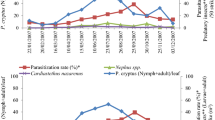Abstract
During the survey of the natural enemies ofSaccharicoccus sacchari in Barbados in 1968 and 1969, the following six indigenous species of natural enemies were recorded: —Hyperaspis trilineata andNephus sp.(Coccinellidae); Oligota barbadorum (Staphylinidae); an unidentified Cecidomyid(Cecidomyidae); Pseudaphycus mundus (Encyrtidae) andAspergillus sp. (Aspergillacae).
Of these,H. trilineata was found in fair numbers in the Westmoreland (St. James) area only;Aspergillus sp. was more abundant during the wet season, while the other species were recorded usually in small numbers from most parishes.
As the indigenous natural enemies do not provide effective control of the pest, three exotic predators and one parasite were introduced into Barbados, through the Commonwealth Institute of Biological Control.Cryptolaemus montrouzieri, Hyperaspis sp. andNephus sp. were obtained from India andAnagyrus saccharicola from East Africa. OnlyA. saccharicola became established. It was recovered soon after its release and, augmented by additional releases, spread rapidly. In January 1972, the levels of parasitism in the dry, intermediate and high rainfall areas were: 8.3, 9.0 and 9.7%.
Résumé
Au cours d'une enquête effectuée dans l'île des Barbades en 1968 et 1969, six ennemis naturels deSaccharicoccus sacchari ont été observés. Ce sont:Hyperaspis trilineata, Nephus sp.(Coccinellidae), Oligota barbadorum (Staphylinidae), unCecidomyidae non identifié,Pseudaphycus mundus (Encyrtidae) etAspergillus sp. (Aspergillacae).
H. trilineata a été trouvé en assez grand nombre, mais seulement dans la région de Westmoreland (St. James).Aspergillus sp. était plus abondant pendant la saison humide; les autres espèces ont été rencontrées en petit nombre dans presque toutes les localités.
Puisque les ennemis naturels indigènes ne sont pas efficaces contre l'insecte nuisible, 3 prédateurs et un parasite d'origine étrangère ont été introduits aux Barbades par les soins du «Commonwealth Institute of Biological Control»:Cryptolaemus montrouzieri, Hyperaspis sp. etNephus sp. provenaient de l'Inde etAnagyrus saccharicola d'Afrique orientale. SeulA. saccharicola réussit à s'implanter; il a été retrouvé peu après sa libération dans l'île et, après de nouvelles introductions, il s'est rapidement répandu. En janvier 1972, les taux de parasitisme, dans les régions sèches, intermédiaires et à pluies abondantes étaient respectivement de: 8,3, 9,0 et 9,7%.
Similar content being viewed by others
Références
Ahmad, T. — 1942. Report of the second entomologist (Dipterist) in charge of the scheme for research on insect pests of sugar cane. —Sci. Rep. agric. Res. Inst. new Delhi, 1940–41, 64–65.
Barreto, B. T. — 1932. Les chinches harinosas de la cana de azucar. —Mems. Asoc. Téc. azuc. Cuba,5, 132–134.
Beardsley, J. W. — 1960. Observations on sugar cane mealybugs in Hawaii. —Proc. int. Soc. Sug. Cane Technol.,10, 954–961.
Box, H. E. — 1953. List of sugar cane insects. —Commonw. Inst. Ent., London, 101 p.
Dymond, G. C. — 1929. Mealybugs. Their effect on cane culture and manufacture in Natal. —Proc. S. Afr. Sug. Technol. Ass.,3, 51–53.
Isaac, P. V. &Misra, C. S. — 1933. The chief insect pests of sugar cane and methods for their control. —Agriculture Live-Stk India,3, 315–324.
Mani, M. S. — 1939. Description of new and records of some known Chalcidoid and other Hymenopterous parasites from India. —Indian J. Ent.,1, 69–99.
Pemberton, C. E. — 1933. Entomology. —Ann. Rep. Comm. Expt. Sta. Hawaii Sug. Pl. Ass. 1932, 18–22.
Puttarudriah, M. — 1954. The status of the mealybug on sugarcane with special reference to Mysore State. —Indian J. Ent.,16, 1–10.
Swezey, O. H. — 1931. Some recent parasite introductions in Hawaii. —J. econ. Ent.,14, 945–947.
Swezey, O. H. & Pemberton, C. E. — 1932. Entomology. —Ann. Rep. Comm. Expt. Sta. Hawaii Sug. Pl. Ass. 1930–31, 19–32.
Timberlake, P. H. — 1932. Three new parasiticHymenoptera from the Indo-Malayan Region. —Proc. Hawaii. ent. Soc.,8, 153–162.
Uichanco, L. B. — 1934. A twenty-five year balance sheet for economic entomology. —Philipp. Agric.,23, 419–429.
Uichanco, L. B. &Villanueva, F. E. — 1932. Biology of the pink mealybug of sugar cane,Trionymus sacchari (Cockerell) in the Philippines. —Philipp. Agric.,21, 205–276.
Author information
Authors and Affiliations
Rights and permissions
About this article
Cite this article
Alam, M.M. The establishment ofAnagyrus saccharicola Timb. [Hymenoptera: Encyrtidae] in Barbados, West Indies, against the sugarcane mealybug,Saccharicoccus sacchari (Ckll.) (Hemiptera: Coccidae]. Entomophaga 17, 357–363 (1972). https://doi.org/10.1007/BF02371644
Issue Date:
DOI: https://doi.org/10.1007/BF02371644




